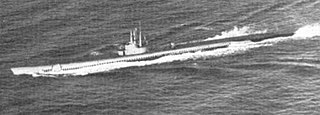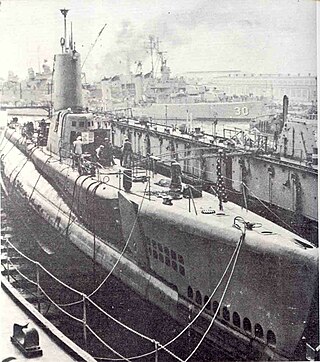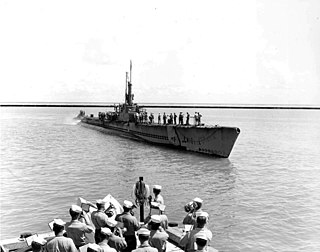
USS Runner (SS/AGSS-476), a Tench-class submarine, was the second ship of the United States Navy to be named for the runner, an amberfish inhabiting subtropical waters.

USS Carbonero (SS/AGSS-337) was a Balao-class submarine, the first ship of the United States Navy to be named for the carbonero, a salt-water fish found in the West Indies.

USS Pipefish (SS-388/AGSS-388), a Balao-class submarine, was the only ship of the United States Navy to be named for the pipefish.

USS Cutlass (SS-478), is a Tench-class submarine now in the service of the Republic of China Navy. She was the only ship of the United States Navy to be named for the cutlassfish, a long, thin fish found widely along the coasts of the United States and in the West Indies. Her keel was laid down by the Portsmouth Navy Yard on 10 July 1944. She was launched on 5 November 1944 sponsored by Mrs. R. E. Kintner, and commissioned on 17 March 1945 with Commander Herbert L. Jukes in command.

USS Remora (SS-487), a Tench-class submarine, was the only ship of the United States Navy to be named for the remora, a fish with a suctorial disk on its head enabling it to cling to other fish and to ships.

USS Odax (SS-484), a Tench-class submarine, was the only ship of the United States Navy to be named for odax, a brilliantly colored, red and green fish belonging to the family Scaridae, the parrot fishes.

USS Irex (SS-482), a Tench-class submarine, was the only ship of the United States Navy to be named for the irex, one of the oceanic fishes belonging to the family carangidae.

USS Medregal (SS-480/AGSS-480), a Tench-class submarine, was the only ship of the United States Navy to be named for the medregal, a streamlined, fast-swimming, bluish-colored fish of the jack family which abounds in waters of the West Indies and in the Atlantic as far north as the Carolinas.

USS Cabrilla (SS/AGSS-288), a Balao-class submarine, was a ship of the United States Navy named for the cabrilla, an edible fish inhabiting the Mediterranean Sea and waters off the coast of California.

USS Devilfish (SS/AGSS-292), a Balao-class submarine, was a ship of the United States Navy named for the devil fish.

USS Hackleback (SS-295), a Balao-class submarine, was a ship of the United States Navy named after the hackleback, a freshwater fish of the sturgeon family.

USS Manta (SS/ESS/AGSS-299), a Balao-class submarine, was the first submarine and second ship of the United States Navy to be named for the manta.

USS Roncador (SS/AGSS/IXSS-301), a Balao-class submarine, was a ship of the United States Navy named for the roncador.

USS Halfbeak (SS-352), a Balao-class submarine, was a ship of the United States Navy named for the halfbeak.

USS Sea Poacher (SS/AGSS-406), a Balao-class submarine, was a vessel of the United States Navy named for the sea poacher, a slender, mailed fish of the North Atlantic.

USS Cubera (SS-347), a Balao-class submarine, was a ship of the United States Navy named for the cubera, a large fish of the snapper family found in the West Indies.

USS Sablefish (SS/AGSS-303), a Balao-class submarine, was a ship of the United States Navy named for the sablefish, a large, dark fish found along North America's Pacific coast from California to Alaska.

USS Loggerhead (SS-374/AGSS-374), a Balao-class submarine, was a ship of the United States Navy named for the loggerhead, Caretta caretta, a very large, carnivorous sea turtle common in the warmer parts of the Atlantic, Pacific, and Indian Oceans.

USS Sea Cat (SS/AGSS-399), a Balao-class submarine, was a ship of the United States Navy named for a shortened form of sea catfish, a marine fish of little food value found off the southeastern coast of the United States commissioned on 16 May 1944, with Commander Rob Roy McGregor in command. During World War II Sea Cat operated within the Pacific theatre, conducting four war patrols in wolf packs accounting for up to 17400 tons in the form of three cargo ships and an enemy vessel. Sea Cat earned three battle stars for her World War II service.

The T-1-class submarines were a pair of submarines designed by the United States Navy and built in the early 1950s for use in training submarine personnel and testing submarine equipment. Both submarines of the class served in these roles for over 19 years.




















